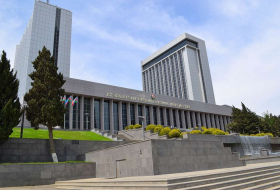Five heavily armed gunmen burst into the chamber, spraying a hail of bullets that left Prime Minister Vazgen Sargsian, parliament speaker Karen Demirchian, and several other leading politicians dead.
Looking back years later, the parliament shooting marked the end of Armenia's development as an emerging democracy with balanced political and social institutions, and the beginning of its slide into a semi-authoritarian state dominated by a powerful president.
The gunmen claimed to be carrying out a coup d'etat, prompted by what their ringleader, former journalist Nairi Hunanian, called "the miserable situation of our people."
"The people are starving. In Armenia, there is no positive movement or evolution," Hunanian said, speaking to journalists during a brief hostage standoff that followed the shootings.
The five men surrendered to authorities on the morning of October 28, and in 2003 they were sentenced to life in prison for the murders. During the trial, Hunanian said that by killing Sargsian, he had helped restore "constitutional order" by strengthening the position of then-President Robert Kocharian.
The long trial of the gunmen, however, failed to shed light on key questions, including how the former journalist was able to get an accreditation to parliament through Armenian state television, or how the men were able to get their weapons and ammunition into the chamber.
The trial was hastily brought to an end just as Hunanian was reportedly about to reveal new information about the crime, and many are convinced that the real masterminds of the shooting remain unknown. One of the gunmen, Vram Galstian, was found hanged in his prison cell in April 2004, an apparent suicide.
"The preliminary investigation that lasted about a year, and the court proceedings that lasted for more than three years, revealed little more than was clear already within days of the terrorist attack. Suspicions that the terrorist act could have been the work of a mastermind were not dispelled.
Analysts agree that the events of October 27 were deeply traumatic for the entire country, shaking confidence that the newly independent state was capable of governing itself. Armenians have never fully recovered from the feelings of vulnerability and shock that were produced by seeing repeatedly on television how vicious thugs were able to gun down the country`s most powerful politicians in the parliament chamber.
In the wake of the tragedy, President Kocharian was able to quickly consolidate power, and in the ensuing years he was able to dismantle Armenia`s emerging democratic institutions. The legislature ceased to be an independent locus of political power. The country`s leading independent television station was closed down. Political parties were weakened to the point of irrelevance.
The question that has troubled people for a decade is whether or not there was a force that stood behind, and guided, the gunmen in the parliament chamber. "That question has yet to receive a clear and well-established answer. A big question mark remains.
"As of now, only one thing is clear. After October 27, authority in Armenia became very monolithic, with a single center."
The shooting also derailed the process of settling the conflict with neighboring Azerbaijan over Nagorno-Karabakh.
On the very day of the 1999 shootings, Prime Minister Sargsian had met with a smiling U.S. Deputy Secretary of State Strobe Talbott, and there was a palpable sense that a road map for settling the dispute was within reach.
As Kocharian -- who was president of the self-declared government of Nagorno-Karabakhfrom 1994-97 -- solidified his grip on power, those hopes became increasingly elusive.
The brazen act of political terrorism, captured in television footage that was shown repeatedly to the nation in the days that followed, traumatized the small South Caucasus country.
It is not always easy to define precise turning points in a country`s history, but for post-Soviet Armenia, the tragedy of October 27, 1999, was just such a moment.
The act of October 27 was a terrorist usurpation of power realized through a state coup. With that, terrorism, as such, became the administration’s main tool in maintaining and reproducing authority in the future: directed not only against individuals, but also against the entire public. The act of October 27, is not a completed act, a murder against people, state officials, but a continuous terrorist act-in-process, a treachery against Armenian statehood, against Armenia’s state security and so far continues to bring about disasters that are fatal for the nation. Neither uncovered nor sentenced, the consequences of October 27 not only are not recovering, but the crime still continues today with more episodes disastrous and fatal for the nation that materialize more with time.
More about: Armenia
















































